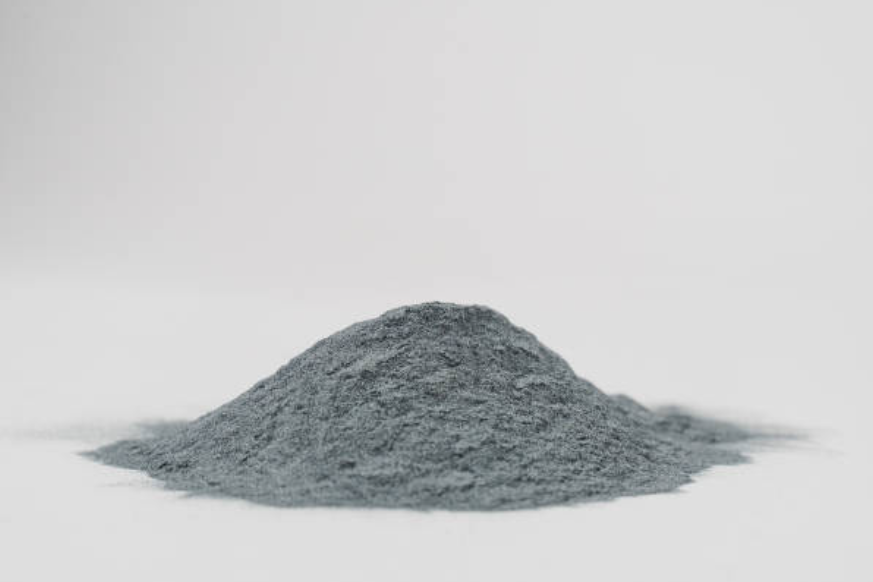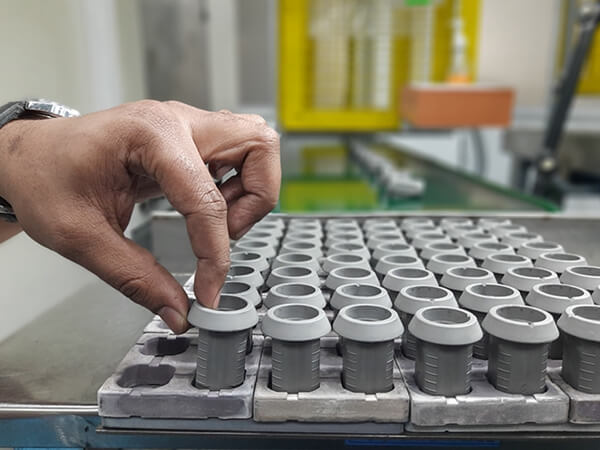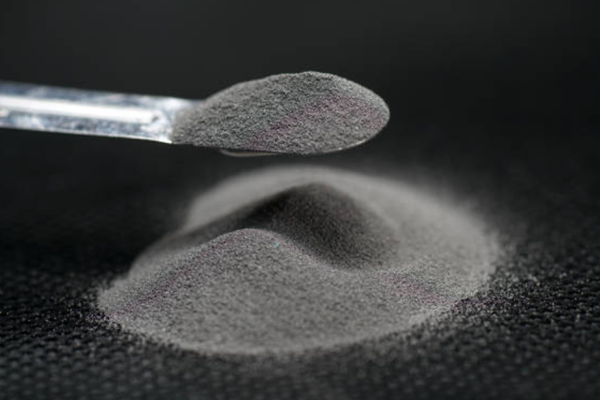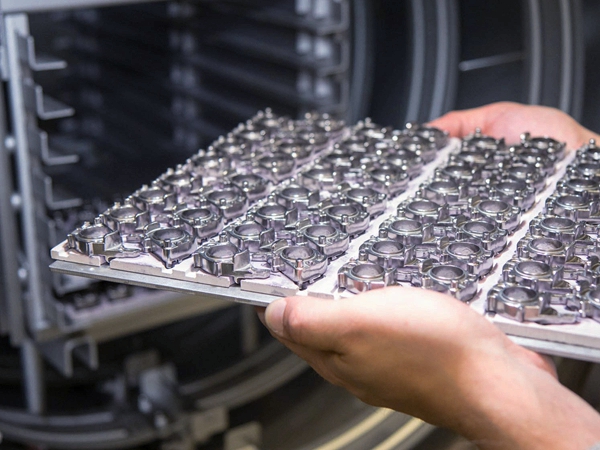MIM-304
Overview of MIM and PCM Processes
The essential advantage of both MIM and PCM is that the molding process defines the complex final part geometry before sintering creates the solid metal piece. It enables intricate, high-precision metal components.
Metal Injection Molding (MIM)
Metal Injection Molding (MIM) is a net molding process that combines the advantages of plastic injection molding and powder metallurgy. The MIM process includes the following steps:
- Metal powders are mixed with a thermoplastic binder to create a feedstock material that flows like plastic
- The feedstock is then injected into a mold using injection molding, filling the cavity and forming the desired shape
- After molding, the "green" part is removed from the mold and goes through a debinding process to remove the binder
- Debinding can involve solvent extraction or thermal decomposition to remove the binder material
- The brown part that remains after debinding still retains the molded shape
- The brown part then goes through sintering, where high temperatures densify the metal powder into a solid metal part
Powder Compression Molding (PCM)
Powder Compression Molding (PCM) is a shape process that combines the advantages of compression molding and powder metallurgy. PCM process includes following steps:
- Metal powder is filled into a mold cavity or die
- Compression force is applied to the powder at high pressure, compacting the powder into the desired shape
- The "green" part is then ejected and undergoes debinding and sintering, similar to MIM
- PCM typically uses uniaxial presses, but isostatic presses can also be used
- Heat may be applied during compression to improve powder bonding
- Final sintering fuses the powder into a solid metal component with the molded geometry
Advantages of MIM and PCM
- High levels of design flexibility
- Cost-effectiveness for complex, high-volume metal parts
- Ability to produce intricate geometries not possible with other methods
- Wide range of metals and alloys can be used
Disadvantages and Limitations
- High expertise required
- Expensive tooling/equipment costs
- Limitations on part size and geometry complexity
- Potential defects if the process is not tightly controlled
- Restrictions on materials can be used
Understanding Stainless Steel MIM-304 Alloys
Stainless steel MIM-304 is a metal injection molding (MIM) grade powder of austenitic stainless steel that conforms to the AISI 304 alloy specification. Austenitic 304 stainless steels are one of the most common and versatile stainless steel alloys used across many industries. They contain, at minimum, 18% chromium and 8% nickel as the main alloying elements. 304 stainless exhibits excellent corrosion resistance, good formability, and weldability and has relatively high strength. It is also easily sterilized for medical uses.
MIM-304 powders are explicitly designed for metal injection molding processes. The powders have controlled particle size distributions and optimized morphology. Typical applications of MIM-304 parts include medical and surgical instruments, dental implants, watch components, nozzles, valves, and other small precision metal parts needing corrosion resistance. MIM enables complex 304 stainless steel part geometries to be mass-produced at a low cost compared to other manufacturing methods. Finished MIM-304 components have material properties similar to traditional wrought 304 stainless steel alloys in terms of corrosion resistance, strength, etc. MIM-304 is an essential material for injection molding small, intricate stainless steel components with the corrosion resistance and biocompatibility of 304 alloys. The MIM process imparts added benefits of design flexibility and cost-effectiveness at high volumes.

MIM-304 Chemical Composition
MIM-304 is an austenitic stainless steel grade containing 18-20% chromium, 8-10.5% nickel, and low carbon, manganese, silicon, phosphorus, sulfur, and nitrogen content. The balanced composition provides optimal corrosion resistance, strength, and manufacturability for metal injection molding powders. Key alloying elements like chromium and nickel enhance properties like oxidation resistance while minimizing elements like carbon, which reduces harmful carbide precipitation. MIM-304 exhibits an austenitic FCC crystal structure with an excellent combination of properties for precision metal components.
Element | Weight % |
Chromium (Cr) | 18-20% |
Nickel (Ni) | 8-10.5% |
Carbon (C) | 0.03% max |
Manganese (Mn) | 2% max |
Silicon (Si) | 0.75% max |
Phosphorus (P) | 0.045% max |
Sulfur (S) | 0.03% max |
Nitrogen (N) | 0.1% max |
MIM-304 Mechanical Properties
MIM-304 stainless steel exhibits high strength with 500-650 MPa tensile strength, 170-310 MPa yield strength, and 170-310 MPa fatigue strength. It maintains good ductility with 40-50% elongation and 45-65% area reduction. Hardness ranges from 92-201 HV. MIM-304 provides excellent corrosion resistance in a variety of environments. Finer stainless steel powders below 10 microns can further enhance fatigue life, elongation, and corrosion resistance. The combination of strength, flexibility, and corrosion resistance make MIM-304 an ideal choice for small precision metal parts across many demanding applications.
Mechanical Property | Range |
Tensile Strength | 500-650 MPa |
Yield Strength | 170-310 MPa |
Elongation | 40-50% |
Reduction of Area | 45-65% |
Hardness | 92-201 HV |
Fatigue Strength | 170-310 MPa |
Corrosion Resistance | Excellent in a range of environments |
Compare With Other MIM Stainless Steel
MIM-304 is the most widely used all-around stainless steel for metal injection molding. It provides a good balance of corrosion resistance, mechanical properties, weldability, and cost-effectiveness. 316L offers improved corrosion and pitting resistance versus 304 for harsh environments. Martensitic grades like 420, 440C, and 17-4 PH provide exceptionally high hardness and strength but with reduced corrosion resistance. MIM-430 is a lower-cost ferritic stainless option. For superior corrosion resistance in highly corrosive applications, 316 may be used over 304 but with increased cost. 304 is the most versatile and economical MIM stainless grade for small precision parts across various demanding applications.
Stainless Steel Grade | Tensile Strength (MPa) | Elongation (%) | Hardness (HRC) | Corrosion Resistance | Data Sheet |
515 - 620 | 40 - 60 | 70 - 90 | Excellent | View PDF | |
485 - 590 | 40 - 60 | 70 - 85 | Excellent | View PDF | |
930 - 1310 | 5 - 15 | 30 - 45 | Good | View PDF | |
1340 - 1600 | 5 - 15 | 48 - 58 | Fair | View PDF | |
1900 - 2300 | 1 - 2 | 58 - 65 | Moderate | View PDF | |
450 - 600 | 20 - 30 | 20 - 30 | Good | View PDF | |
515 - 620 | 30 - 50 | 70 - 90 | Excellent | View PDF |
Key Takeaways:
- 304 is the most commonly used standard stainless steel, offering good corrosion resistance and balanced mechanical properties.
- 316L improves corrosion resistance, especially against pitting and acids, but has slightly lower strength. Famous for medical uses.
- 17-4 PH has high strength, hardness, and moderate corrosion resistance. They are used where high strength is critical.
- 420 provides increased hardness and wear resistance versus 304.
- 440C is a high carbon martensitic grade optimized for very high hardness at the expense of corrosion resistance.
- 430 provides essential corrosion protection at a low cost but has lower strength.
Grade | Corrosion Resistance | Strength | Hardness | Magnetism | Key Applications |
304 | Excellent | Medium | Medium | Slight | Consumer products, medical, marine |
316L | Excellent, improved over 304 | Medium-High | Medium | Non-magnetic | Medical implants, food processing |
17-4 PH | Moderate | Very High | High | Magnetic | Aerospace, oil & gas, tooling |
420 | Moderate | Medium-High | Medium | Magnetic | Cutlery, surgical tools, valves |
440C | Moderate | Very High | Very High | Slightly magnetic | Cutting tools, bearings, knives |
430 | Poor | Low | Low | Magnetic | Appliances, automotive |
316 | Excellent, similar to 316L | Medium | Medium | Slightly magnetic | Chemical processing, pharmaceutical |
Applications of MIM-304
The key advantages of MIM 304 in these applications are corrosion resistance, high strength-to-weight ratio, complex geometries, precision, and economical high-volume production. The MIM process enables small, intricate 304 stainless steel components to be manufactured cost-effectively. Here are some of the critical applications and industries utilizing stainless steel MIM-304 powders:
Medical - Surgical instruments, dental implants, orthopedic implants, medical devices requiring sterilization and biocompatibility.
Consumer Products - Watch cases, watch bands, eyewear components, jewelry.
Automotive - Small precision metal parts like valves, gears, and pump components.
Aerospace - Critical components, including turbine blades, fuel system parts, and fasteners.
Chemical Processing - Corrosion-resistant piping, valves, fittings, and pump parts.
Electrical - Sensors, connectors, power distribution components, insulation fasteners.
Marine - Corrosion-resistant hardware, propeller shafts, marine fittings.
Food/Beverage - Corrosion-resistant metal tubing, instrumentation, valves, and machine parts.
Oil and Gas - Wellhead components, downhole tools, valves, fasteners, and pump parts.



